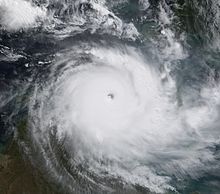
| Part of a series on |
| Tropical cyclones |
|---|
 |
|
Outline Media coverage |
Tropical cyclones are non-frontal, low-pressure systems that develop, within an environment of warm sea surface temperatures and little vertical wind shear aloft.[1] Within the Australian region, names are assigned from three pre-determined lists, to such systems, once they reach or exceed ten–minute sustained wind speeds of 65 km/h (40 mph), near the center, by either the Australian Bureau of Meteorology, Papua New Guinea's National Weather Service or Indonesia's Badan Meteorologi Klimatologi dan Geofisika.[1] Within the Australian region, tropical cyclones have been officially named since the 1963–64 Australian region cyclone season, though several meteorological papers show that a few tropical cyclones were named before 1964–65.[2][3][4] The names of significant tropical cyclones that cause a high amount of damage and/or loss of life are retired from the lists of tropical cyclone names by the World Meteorological Organization's RA V Tropical Cyclone Committee at their bi-annual meeting. Storms named by Port Moresby are automatically retired regardless of their impact due to their infrequent occurrence.[1]
Within the Australian region, there have been a total of 134 tropical cyclone names retired. Among the retired storms are cyclones Gwenda and Inigo, two of the most intense systems ever recorded in the Southern Hemisphere; both attained a barometric pressure of 900 hPa (26.58 inHg). The deadliest cyclone to have its named retired was Cyclone Seroja in 2021, which killed 272 people in Indonesia, East Timor and Australia, while the most damaging system to have its name retired was Severe Tropical Cyclone Tracy in 1974 which devastated the city of Darwin, leaving A$837 million (A$5.65 billion 2019 AUD; US$2.64 billion 2019 USD) in losses.
- ^ a b c RA V Tropical Cyclone Committee (2023). Tropical Cyclone Operational Plan for the South-East Indian Ocean and the Southern Pacific Ocean 2023 (PDF) (Report). World Meteorological Organization. Retrieved 23 October 2023.
- ^ Terry, James P. (2007). "3.4". Tropical cyclones: climatology and impacts in the South Pacific. Springer. pp. 30–31. ISBN 9780387715421.
- ^ Callaghan, Jeff (18 August 2004). "Tropical Cyclone Impacts along the Australian east coast from November to April 1858–2000" (PDF). Australian Severe Weather. Retrieved 25 February 2011.
- ^ Unattributed (13 March 2010). "Tropical cyclones in Vanuatu: 1847 to 1994" (PDF). Vanuatu Meteorological Service. Pacific Disaster Net. Archived from the original (PDF) on 5 April 2015. Retrieved 25 February 2011.
© MMXXIII Rich X Search. We shall prevail. All rights reserved. Rich X Search
